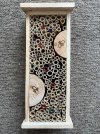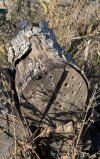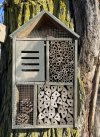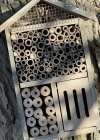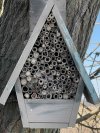I've been inside swarms of mason bees around my apple trees during blossom time and never had a problem with getting stung. I really like how much better pollinators they are than honeybees. I have noted that in the orchards around the farms where we have lots of mason bees that we also have a much higher percentage of blossoms that turn into apples.
I'm not so sure about buckwheat for them though. Around here, the mason bees have already packed their nests with cocoons and expired by the time the buckwheat flowers. The end of the lilac bloom seems to coincide with the end of their ephemeral existence. But buckwheat is great for other varieties of beneficial native bees around here.
Dragging a big old dead pine tree trunk with carpenter ant holes in it into an orchard has worked well for providing the mason bees with habitat they can bore nesting holes into, but for the price of these nesting houses from Menards, I am not going to go through that much work to help out the orchards that need more mason bees. I ordered four of the houses just now. The delivered cost, including tax, for four came to $36.82.
My understanding is that the houses should be placed at least three feet above ground level to deter ants, be angled slightly downward to encourage rain runoff, face south or east for early morning warm up when the cocoons hatch, and be covered with chicken wire if squirrels are a problem. For larger orchards, one nesting house every 200 feet seems about right to me. For the interior of an orchard that is over 100 feet from a nesting house, well then the ole dead log trick still holds. The log can be as short as a stick of firewood if need be.
My philosophy the past couple years, right or wrong, has been to start improving mason bee habitat shortly after planting new fruit trees when we plant wholesale orders of them. The bees aren’t needed until years later when the trees start blossoming, but when they do start blossoming, it is good to have already built up a large number of mason bees to get the job done.
I have been able to determine which orchards already have mason bees by getting out there during blossom time on a bright sunny day and then taking photos with my phone of the side of the tree that is in full sun. Most bees will be a blur because they are moving so quickly, but I get a few that are stationary just long enough to get a clear photo of them. Then I compare their photos with mason bee photos on the internet. As H2Oflwer mentioned, the cocoons are available for purchase online. I got some from Mason Bees for Sale one year and they all seemed to hatch.




